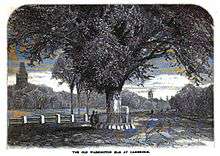Washington Elm

The Washington Elm was a tree on Cambridge Common in Cambridge, Massachusetts that lived approximately 210 years and died in 1923.
History
Beginning as early as the 1830s, it became popular legend that "under this tree Washington first took command of the American Army", supposedly words of Henry Wadsworth Longfellow. The publication of the fictional "eye-witness" journal The Diary of Dorothy Dudley in 1876 furthered the legend. Although George Washington did take command of the army on 3 July 1775, there is no official documentation stating that this event took place under the tree.
In 1923, the tree was very fragile and diseased. Workers from the parks department of Cambridge were cutting two of the remaining limbs. Upon cutting the second limb, the entire tree fell over onto its iron fence and brought the Boston Elevated Railway cable to within 15 feet (4.57 m) of the ground. The tree was divided up into approximately 1000 pieces, and these were distributed to all states and their legislatures. The cross-section of the tree was sent to Mount Vernon. About 150 pieces were given over the counter, a few hundred were mailed throughout the country, and some fraternal organizations received pieces as well.
In 1925, the legend was openly discredited at the Cambridge Historical Society (CHS), when Samuel F. Batchelder read a paper[1] he later reprinted as The Washington Elm Tradition: "Under This Tree Washington First Took Command of the American Army" Is It True?. Batchelder revealed the forgeries in the tales told about Washington and the tree, in short calling the myth altogether not realistic, but the beliefs persist today. Many websites are outdated in stating that the tree still exists and that it is indeed where Washington first took command.
Today, a plaque embedded in the pavement of Garden Street (at its Mason St. intersection) marks where the tree used to stand. The Cambridge Historical Commission (CHC) has called the association of Washington and the elm a "myth" and stated that "the image of the tree remains a symbol of patriotism in Cambridge."[2]
References
External links and further reading
- Howard Mansfield, "The Bones of the Earth". Shoemaker Hoard, 2004, ISBN 1-59376-040-X
-
 Works related to Washington Elm at Wikisource
Works related to Washington Elm at Wikisource
Coordinates: 42°22′35.66″N 71°07′20.00″W / 42.3765722°N 71.1222222°W
